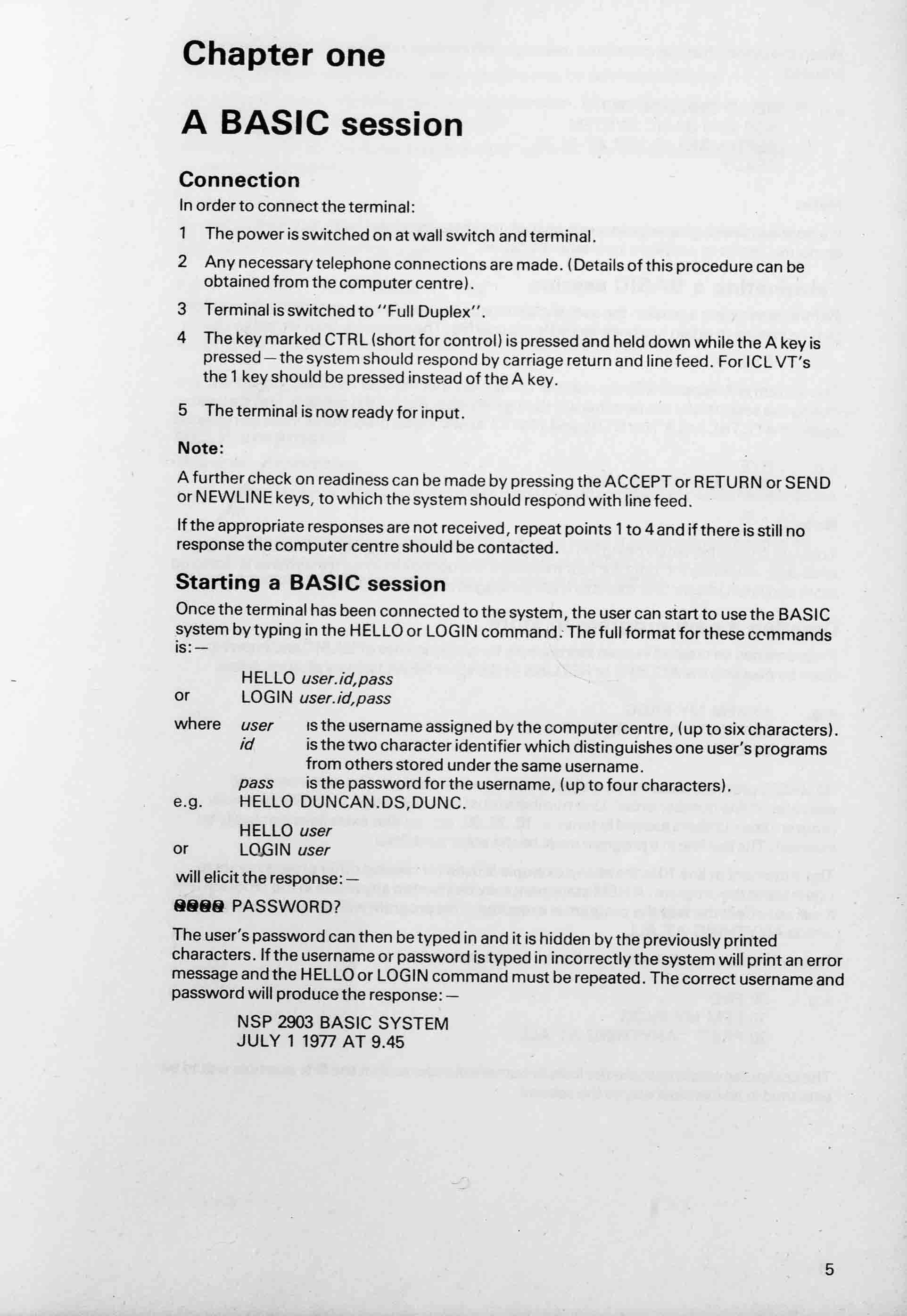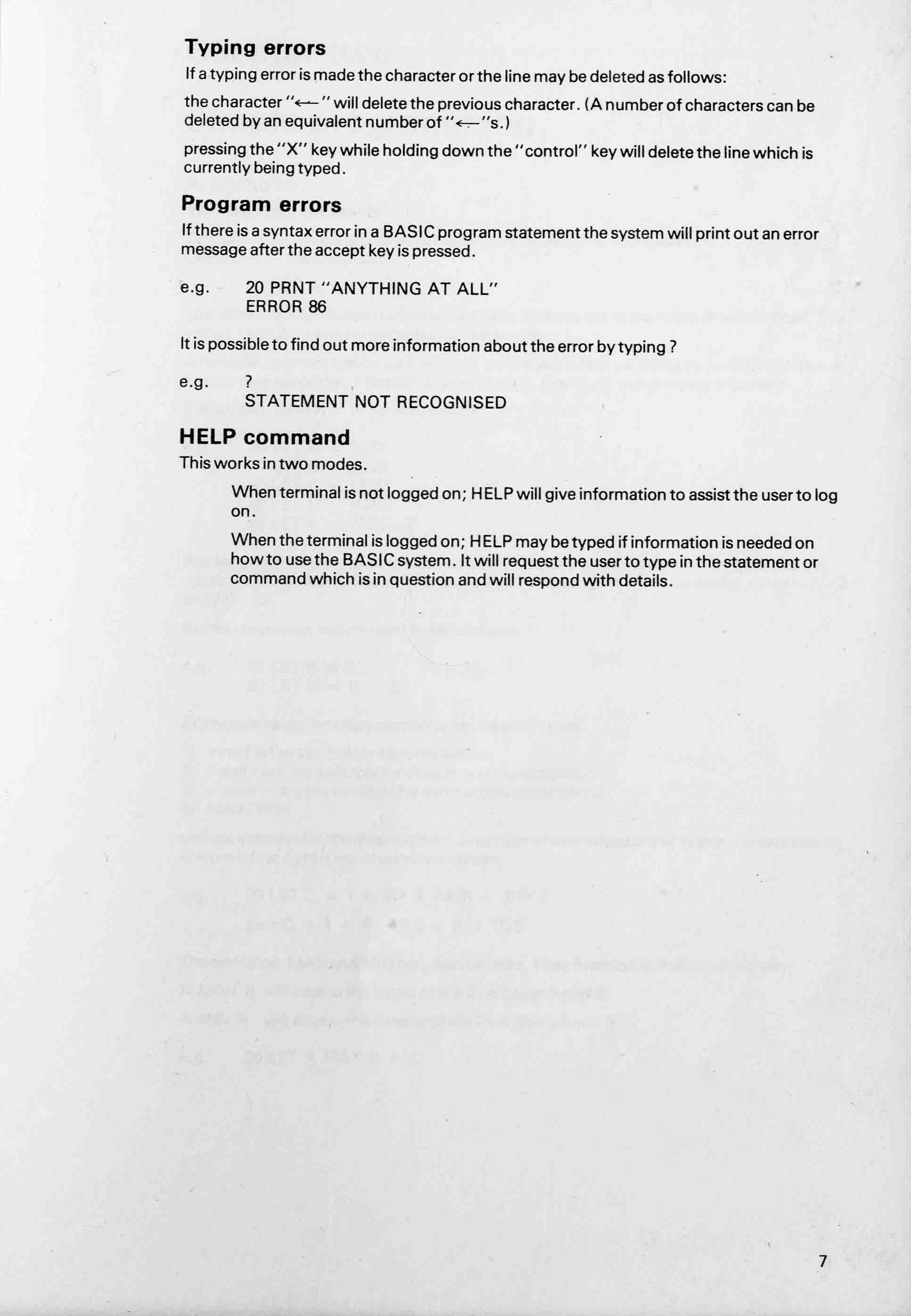Chapter one: A BASIC Session¶



Connection¶
In order to connect the terminal:
- The power is switched on at wall switch and terminal.
- Any necessary telephone connections are made. (Details of this procedure can be obtained from the computer centre).
- Terminal is switched to “Full Duplex”.
- The key marked CTRL (short for control) is pressed and held down while the A key is pressed - the system should respond by carriage return and line feed. For ICL VT’s the 1 key should be pressed instead of the A key.
- The terminal is now ready for input.
Note:
A further check on readiness can be made by pressing the ACCEPT or RETURN or SEND or NEWLINE keys, to which the system should respond with line feed.
If the appropriate responses are not received, repeat points 1 to 4 and if there is still no response the computer centre should be contacted.
Starting a BASIC session¶
Once the terminal has been connected to the system, the user can start to use the BASIC system by typing in the HELLO or LOGIN command: The full format for these commands is:
HELLO *user.id/pass*
Or LOGIN *user.id/pass*
where
- user is the username assigned by the computer centre, (up to six characters).
- id is the two character identifier which distinguishes one user’s programs from others stored under the same username.
- pass is the password for the username, (up to four characters).
e.g.:
HELLO DUNCAN.DS,DUNC
HELLO *user*
Or LOGIN *user*
will elicit the response:
@@@@ PASSWORD?
The user’s password can then be typed in and it is hidden by the previously printed characters. If the username or password is typed in incorrectly the system will print an error message and the HELLO or LOGIN command must be repeated. The correct username and password will produce the response:
NSP 2903 BASIC SYSTEM
JULΥ 1 1977 ΑΤ 9.45
When the system has completed the message with carriage return and line feed, work may proceed.
e.g.:
HELLO DUNCAN, DUNC
NSP 2903 BASIC SYSTEM
SΕΡΤΕΜΒΕR 19 1977 ΑΤ 14.22
READY
Note:
It is possible that the introductory message shown here may have been modified by the computer centre to provide a local identification.
Terminating a BASIC session¶
Before terminating a session the user should ensure that any program or data in main store that he wishes to retain has been stored in his userfile. The session is then ended by typing
ΒΥΕ
The system will respond with the number of minutes that the user has been logged on during the session and the terminal will then go off-line. Before the terminal may be used again, the “CTRL and A” (or CTRL and 1 for VT’s) and logon procedures must be repeated.
e.g.:
ΒΥΕ
0014 ΜΙΝS.ΤΕRΜ.ΤΙΜΕ.
Note:
To avoid on-line terminals being left unattended a “time-out” system is used; if a program executing is waiting for input for four minutes it will be broken into; if a terminal is doing no work and is left idle for four minutes it will be logged off automatically.
Creating a new program in store¶
Programs can be created in main store simply by typing in lines of BASIC and entering them by pressing the ACCEPT or RETURN or SEND or NEWLINE key after each line.
e.g.:
10 REM MY PROG
20 ΡRΙΝΤ "ΑΝΥΤΗΙΝG ΑΤ ΑLL"
30 END
All BASIC program statements are preceded by a line number. The statements are executed in line number order. Line numbers must be in the range 1 to 9999. Normally program line numbers ascend in tens i.e. 10, 20, 30, etc. so that extra lines can easily be inserted. The last line in a program must be the statement END.
The statement at line 10 in the above example is used for helping other programmers to understand the program. A REM statement may be inserted anywhere in the program and it will not affect the way the program is executed. This program will print on the terminal words ANYTHING AT ALL. The programmer could have typed in the lines in any order.
e.g.:
30 END
10 REM MY PROG
20 ΡRΙΝΤ "ΑΝΥΤΗΙΝG ΑΤ ΑLL"
The computer would execute the lines in numerical order so that the first example would be executed in an identical way to the second.
Typing errors¶
If a typing error is made the character or the line may be deleted as follows:
the character “←” will delete the previous character. (A number of characters can be deleted by an equivalent number of “←”s.)
pressing the “X” key while holding down the “control” key will delete the line which is currently being typed.
Program errors¶
If there is a syntax error in a BASIC program statement the system will print out an error message after the accept key is pressed.
e.g.:
20 ΡRΝΤ "ΑΝΥΤΗΙΝΟ ΑΤ ΑLL"
ERROR 86
It is possible to find out more information about the error by typing ?
e.g.:
?
STATEMENT NOT RECOGNISED
HELP command¶
This works in two modes.
When terminal is not logged on; HELP will give information to assist the user to log on.
When the terminal is logged on; HELP may be typed if information is needed on how to use the BASIC system. It will request the user to type in the statement or command which is in question and will respond with details.
